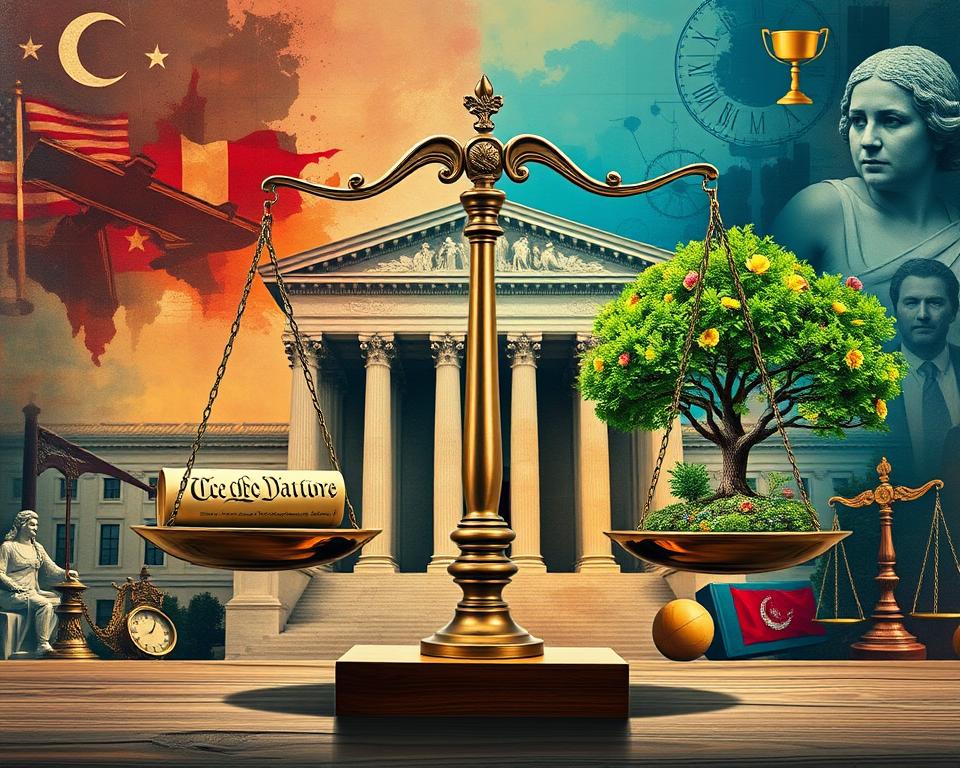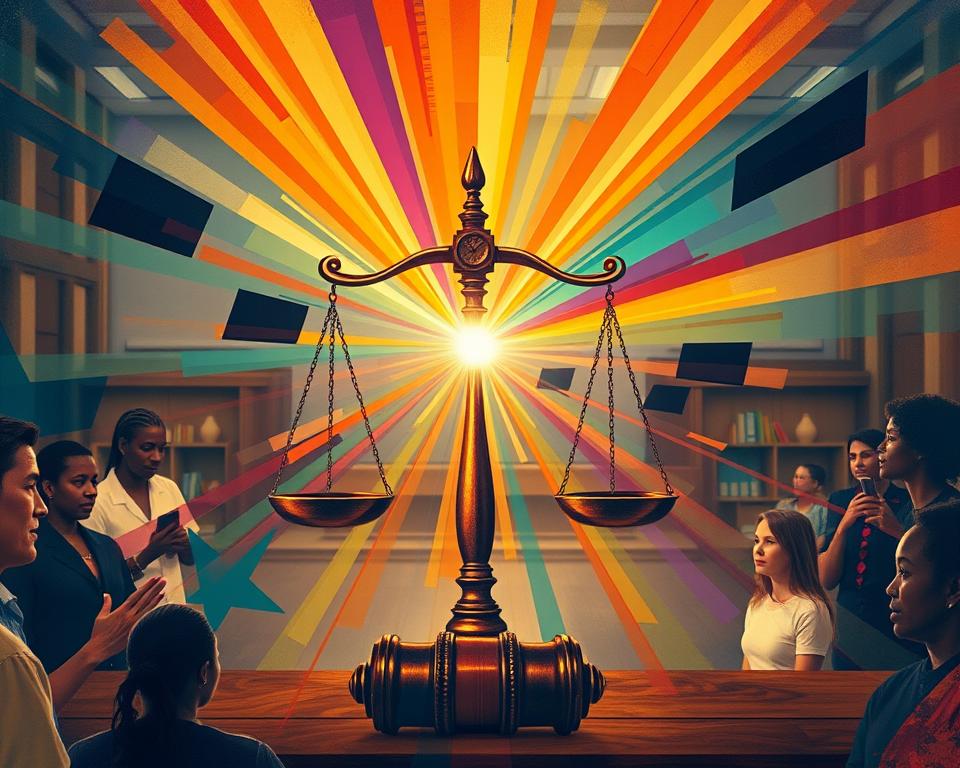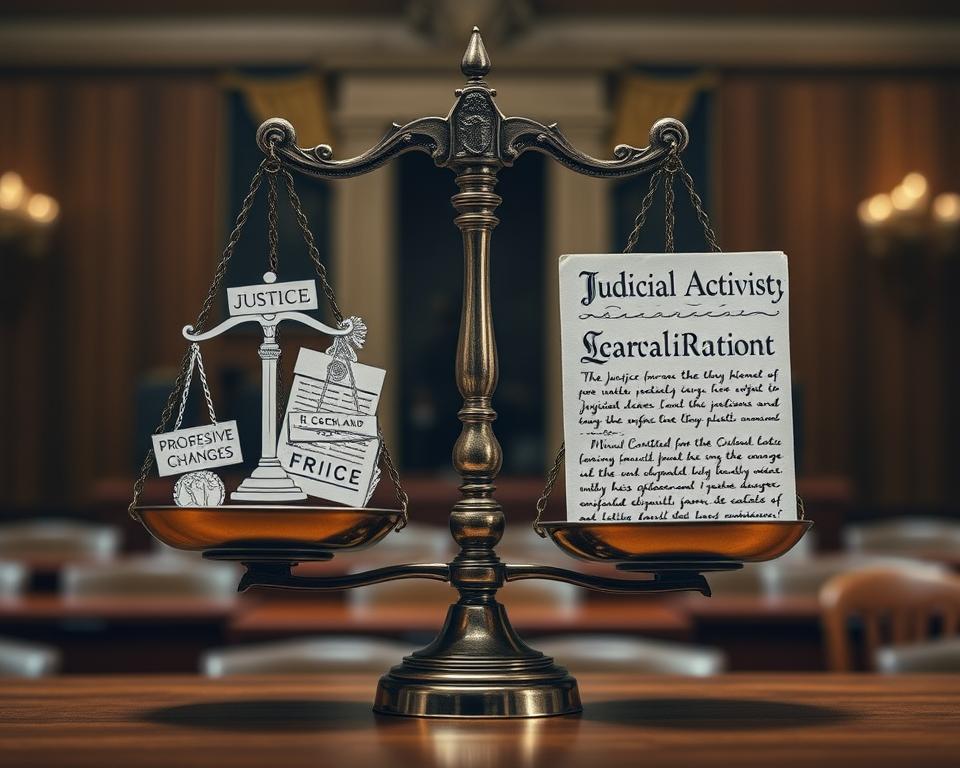Judicial activism is a big topic in the legal world. It’s important to know its good and bad sides. This idea means judges play a big role in making laws, sometimes by saying laws are wrong.
People have different views on this. Looking at the good and bad of judicial activism helps us see how it affects laws and society.
We will look at how judicial activism affects rights, fairness, and the law. By understanding judicial activism, we can see how judges shape laws and what happens because of their choices.
Exploring judicial activism shows us its ups and downs. We can learn a lot about its role in law and its effects on society by looking at both sides.
Key Takeaways
- Judicial activism refers to the practice of judges taking an active role in shaping the law.
- The pros and cons of judicial activism are essential to understanding its impact on the legal system and society.
- Judicial activism can have significant effects on individual rights and social justice.
- The interpretation of the constitution is a critical aspect of judicial activism.
- Understanding the judicial activism definition is crucial for evaluating its applications and consequences.
- The role of judges in shaping the law is a topic of ongoing debate and discussion.
What is Judicial Activism?
Judicial activism is when judges actively shape the law. They often strike down laws they see as unconstitutional. The judicial activism definition is complex. It means judges play a big role in interpreting laws and making decisions that affect society.
Definition and Overview
Many scholars and legal experts debate judicial activism. Some say it’s needed to protect rights. Others believe it goes too far. Examples of judicial activism include Roe v. Wade and Brown v. Board of Education. These cases had big impacts on society and politics.
Historical Context
Judicial activism has a long history in the United States. The Supreme Court started asserting its power early on. Over time, some judges have been more active in shaping laws. Others have been more cautious.
Key Examples
Some key examples of judicial activism are Obergefell v. Hodges and Citizens United v. FEC. These cases show how judicial activism can change society and politics. They highlight the power of judges in shaping our laws.
The Role of Courts in Society
Courts are key in a democratic system. They check the power of other government branches and protect our rights. An independent judiciary is vital for this. It makes decisions based on the law, not on fear or politics.
An independent judiciary is very important. It’s the heart of democracy, keeping power in check. Arguments for judicial activism stress the need for courts to defend our rights and fight for justice. For instance, courts must weigh the good and bad of the death penalty, considering the risk of wrong convictions and its societal effects.
Function of Courts in a Democratic System
In a democratic system, courts have several key roles. These include:
- Interpreting the law and ensuring it’s applied fairly
- Protecting individual rights and promoting social justice
- Providing a check on the other branches of government
By doing these things, courts are crucial for keeping power balanced in a democracy.
Pros of Judicial Activism
Judicial activism has many benefits. It protects individual rights and promotes social justice. It helps address issues that other branches of government can’t handle well.
The arguments for judicial activism focus on the judiciary’s duty. They say the court must interpret the Constitution. This ensures all individuals’ rights are protected, including against racial discrimination, gender inequality, and lack of healthcare access.
Protection of Individual Rights
Judicial activism is key in safeguarding individual rights, especially for those who are often overlooked. The court ensures laws are fair and just. This promotes equality and fairness for everyone.
Addressing Social Justice Issues
Judicial activism tackles big social justice problems like police brutality, environmental harm, and economic inequality. By actively addressing these, the court works towards a fairer society.
Promoting Constitutional Interpretation
Lastly, judicial activism encourages constitutional interpretation. This is vital for protecting everyone’s rights. By sticking to the Constitution’s original intent, the court supports democracy and the rule of law.
Cons of Judicial Activism
Judicial activism has its downsides, including judicial activism drawbacks that can harm democracy. A big worry is judicial overreach, where judges go beyond their limits and impose their views on the law.
This can spark arguments against judicial activism, as it seems to challenge the balance of power and democracy. It also erodes democratic accountability, since judicial activism can lead to decisions not made by the people.
Threat to Separation of Powers
The separation of powers is key to democracy. Judicial activism can upset this balance. When judges make law based on their own views, it can upset the power balance and harm democracy.
Potential for Judicial Overreach
Judicial overreach is a big worry. It means judges make decisions based on their own opinions, not the law. This can cause judicial activism drawbacks with serious effects.
Erosion of Democratic Accountability
Judicial activism can also erode democratic accountability. It can lead to decisions not answerable to the people. This lack of transparency and accountability can weaken democracy.
- Judicial activism can lead to decisions that are not based on the law
- Judicial overreach can result in an imbalance of power
- The erosion of democratic accountability can undermine the democratic process
| Concerns | Impact |
|---|---|
| Judicial Overreach | Imbalance of Power |
| Erosion of Democratic Accountability | Undermining of Democratic Process |
| Judicial Activism Drawbacks | Far-reaching Consequences |
Comparison of Judicial Activism vs. Judicial Restraint
Judicial activism and judicial restraint are two ways judges make decisions. Knowing what judicial activism is and seeing examples helps us understand these methods. Judicial activism means judges actively shape the law, sometimes by overturning laws or actions by the government. Judicial restraint, however, means judges let other branches of government decide, even if laws are seen as unconstitutional.
To learn more about judicial restraint, check out this website. It explains judicial restraint in detail. Judicial activism, in contrast, is when judges are more proactive in making laws. For example, Roe v. Wade is a case where judges struck down a law.
The table below shows the main differences between judicial activism and judicial restraint:
| Approach | Definition | Examples |
|---|---|---|
| Judicial Activism | Judges take an active role in shaping the law | Roe v. Wade, Brown v. Board of Education |
| Judicial Restraint | Judges defer to the other branches of government | Plessy v. Ferguson, United States v. Butler |
For more on the good and bad of police discretion, visit this website. In summary, knowing the differences between judicial activism and judicial restraint helps us see how judges influence laws.
Notable Cases Reflecting Judicial Activism
Judicial activism has greatly influenced the U.S. legal landscape. Many notable cases show its impact on the legal system and society. These cases highlight the judiciary’s power to interpret laws and guide history.
Examples of judicial activism include Roe v. Wade, Brown v. Board of Education, and Obergefell v. Hodges. These cases have deeply affected the legal system and society. They show judicial activism’s role in fighting for social justice and protecting individual rights.
Landmark Cases
- Roe v. Wade: This case made abortion legal and recognized a woman’s right to choose. It shows judicial activism’s impact on social issues.
- Brown v. Board of Education: This case ended segregation in public schools. It demonstrates judicial activism’s role in promoting equality and justice.
- Obergefell v. Hodges: This case made same-sex marriage legal. It highlights judicial activism’s impact on civil rights and social justice.
These cases show the big impact of judicial activism on the legal system and society. By looking at these examples, we can better understand the judiciary’s role in shaping history and fighting for social justice.
The Impact of Public Opinion on Judicial Activism
Public opinion greatly affects judges’ decisions and case outcomes in the USA. It shapes how judges interpret the law, reflecting society’s values. This means public opinion can deeply influence judicial activism, guiding judges to address social justice and interpret the Constitution.
Some cases show how public opinion impacts judicial activism:
- The Supreme Court’s ruling in Roe v. Wade was influenced by public opinion. It highlighted the need to protect individual rights and promote social justice.
- The Brown v. Board of Education case also showed public opinion’s impact. The Court’s decision was shaped by growing public awareness of racial segregation and the need for equality.
In the USA, public opinion is key in shaping judges’ decisions and case outcomes. By looking at judicial activism and its arguments, we understand the complex factors at play. This helps us see how public opinion influences judicial activism.
Perspectives from Legal Scholars
Legal scholars have different views on judicial activism. Some think it’s key for protecting rights and justice. They say an active court can tackle problems the other branches can’t.
Others, however, are critical of judicial activism. They worry about the court going too far and losing democratic control. They believe courts should be careful and let other branches lead.
Support for Judicial Activism
- Protection of individual rights
- Promoting social justice
- Addressing issues not handled by other branches
Criticism from Scholars
Some scholars also have concerns about judicial activism. They say it can cause:
- Judicial overreach
- Erosion of democratic accountability
- Unstable legal decisions

Middle Ground Opinions
Other scholars see both sides of the issue. They think courts should balance protecting rights with respecting their limits. This way, they can serve justice without overstepping.
Global Perspectives on Judicial Activism
Judicial activism isn’t just a U.S. issue. Other countries also deal with it in their own ways. Learning about judicial activism in different places helps us see how courts influence laws and policies.
International Approaches
In Canada and Australia, courts have a big role in law-making. They protect individual rights. Some see judicial activism as a way to balance power, while others are more cautious.
Comparison with the U.S. Judicial System
Comparing judicial activism in the U.S. with other countries shows both similarities and differences. The U.S. judicial system is often looked up to, but how courts act varies. Some countries limit judicial review, while others give courts more power.
In Canada, the Supreme Court made same-sex marriage legal. In Australia, the High Court decided on indigenous land rights. These cases show how courts can change laws and policies. They also stress the need to understand judicial activism in various contexts.
Judicial Activism in Current Events
Judicial activism in the USA is changing the legal world. Recent big cases are making news. Courts are now interpreting laws and tackling social justice issues in new ways.
Recent High-Profile Cases
Some cases have shown how judicial activism works today. These include:
- Landmark Supreme Court decisions on individual rights
- Challenges to existing laws and policies
- Controversial rulings on social justice issues
These cases show judicial activism’s big impact. It’s changing how laws are applied and understood.
Trends in Judicial Decisions
It seems judicial activism is growing. Courts are playing a bigger role in making laws. This is sparking debate about its role in society.
Judicial activism will keep shaping current events. Courts face tough social and legal challenges. It’s key to grasp its role and effects on the nation.
The Future of Judicial Activism
The future of judicial activism is uncertain. Many factors will shape its role in the legal system. Understanding what judicial activism is is key to predicting its impact.
As the legal world changes, judicial activism will play a big role. It will help guide the courts in new directions.
Predictions and Speculations
Some experts think judicial activism will grow. Courts might take on more social justice issues. This could change how laws are interpreted and applied.
Potential Changes in Legislation
Legislative changes could also shape judicial activism’s future. For example, new laws or changes in how judges are chosen could affect court actions.
The future of judicial activism depends on many things. Courts, legislatures, and the public all play a part. As the legal system evolves, we must think about judicial activism’s impact.
Summary of Key Points
The debate on judicial activism has been going on for a while. Both sides have shared their views on its pros and cons. It’s important to know what judicial activism is to understand its role in the legal system.
Looking back, judicial activism can have both good and bad sides. It can protect individual rights and push for social justice. But, it can also weaken democratic control and lead to judges making too many decisions.
Some important points to remember are:
- The need for an independent judiciary in a democracy
- Courts’ role in safeguarding individual rights and fighting for justice
- The dangers of judicial activism, like losing democratic control

In summary, we need to weigh the pros and cons of judicial activism to make sure the legal system works for everyone. By understanding judicial activism and its effects, we can strive for a fairer and more just society.
| Pros of Judicial Activism | Cons of Judicial Activism |
|---|---|
| Protection of individual rights | Erosion of democratic accountability |
| Promotion of social justice | Potential for judicial overreach |
Additional Resources for Further Reading
If you want to learn more about judicial activism in the USA, there are many resources available. You can find books, articles, and online platforms for legal discussions. These can help you understand the arguments for and against judicial activism better.
Recommended Books and Articles
“The Least Dangerous Branch” by Alexander Bickel is a key read. It talks about the courts’ role in a democratic society. “Active Liberty” by Justice Stephen Breyer also offers valuable insights.
Legal scholars have written important articles too. “Judicial Activism and Its Critics” by Cass Sunstein and “The Rise of Judicial Activism” by Erwin Chemerinsky are must-reads.
Online Platforms for Legal Discussions
Online, you can find discussions on judicial activism. The American Constitution Society has a blog with diverse views on legal issues. The Federalist Society offers conservative legal debates.
The American Bar Association’s website provides balanced resources. It features commentary from legal experts on both sides of the political spectrum.
Exploring these resources can help you understand judicial activism in the USA better. Whether you agree with the arguments for or against, these materials offer valuable insights.



